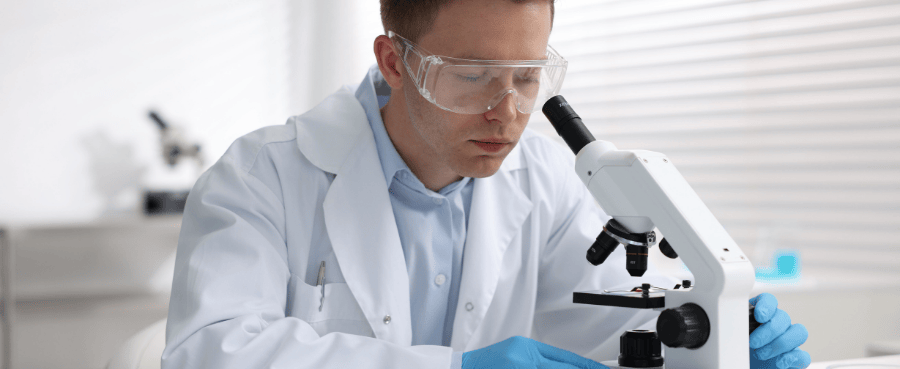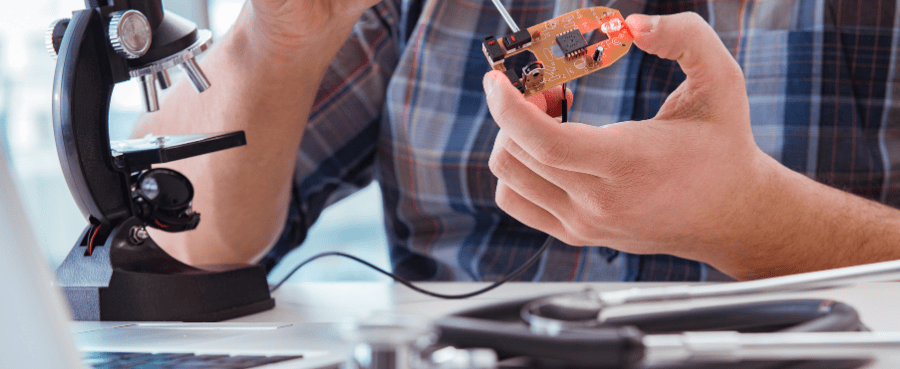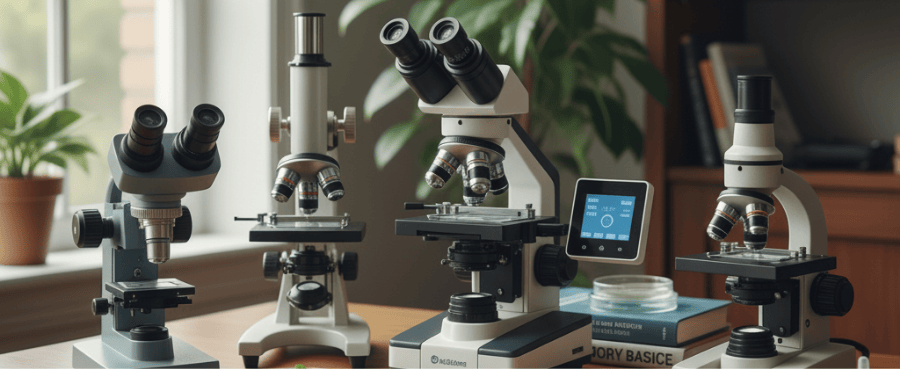The short answer is yes; you can absolutely see bacteria with a digital microscope. However, and this is the crucial part, it has to be the right kind of digital microscope.
This guide will walk you through everything you need to know to avoid common pitfalls, select the right equipment, establish a realistic budget, and
successfully embark on your journey into microbiology.
Understanding the Different Types of Digital Microscopes
First, there are the standard, inexpensive, low-power USB digital microscopes. These are fantastic tools that connect directly to your computer. However, they are powerful, handheld digital magnifying glasses. They excel at viewing the surface details of larger objects, such as coins, insects, or circuit boards, but lack the optical power to resolve individual bacterial cells.
The tool you actually need is a high-power compound digital microscope. This is a traditional laboratory microscope equipped with multiple objective lenses on a rotating turret, but with a digital camera mounted in the eyepiece. This setup combines the powerful, multi-lens magnification of a compound microscope with the ability to view, capture, and record images on a computer screen.

The Key is Magnification and Resolution
- Magnification: This is the measure of how much larger an object appears. To see bacteria as tiny dots, you need a minimum total magnification of 400x. To see their distinct shapes (like rods, spheres, or spirals) and any detail, you really need a magnification of 1000x. This is typically achieved using a 10x eyepiece and a 100x oil-immersion objective lens.
- Resolution: This is the ability to distinguish between two separate points. High magnification is useless without good resolution; otherwise, you just get a larger blur. A quality lens system, a condenser to focus the light, and proper illumination are all critical for achieving the sharp resolution needed to see something less than a few micrometers in size.
Related Reading: What Kind of Microscope you Need to See Sperm
Getting Started: Your First Steps into the Microbial World
What You'll Need: The Essential Equipment
Here is a checklist of the gear you will need. For a beginner, looking at reputable brands like AmScope or OMAX is a great starting point.
- Essential Equipment:
- A Compound Microscope: Ensure it provides total magnification up to at least 1000x. Look for one with a built-in light source and a condenser with an iris diaphragm for light control.
- Mechanical Stage (Highly Recommended): This mechanism holds the slide and allows for smooth movement left/right and forward/backward with control knobs. It is far superior to moving the slide with your fingers and is a must-have for high-magnification work.
- Digital Eyepiece Camera: A dedicated camera that fits into the microscope's eyepiece tube to display the image on your computer. Many beginner microscopes come with one included in a bundle.
- Blank Slides and Coverslips: These are the glass plates that hold your specimen.
- A Dropper or Pipette: For transferring small amounts of liquid samples.
- Optional but Highly Recommended:
- Prepared Bacteria Slides: Buying a pre-made slide is the easiest way to guarantee you see bacteria on your first try and learn what to look for.
- Immersion Oil: Necessary if you plan to use a 100x objective lens for a total magnification of 1000x.
- Microscope Stains: A simple stain, such as methylene blue, makes translucent bacteria visible. A Gram stain kit allows for more advanced identification.
Setting a Realistic Budget: What to Expect
The price of a suitable microscope can vary significantly. Here’s a general guide to what you can expect at different budget levels:
- Entry-Level / Hobbyist ($150 - $300): In this range, you can find a complete kit perfect for beginners, like a Tomolov digital microscope, which often includes up to 1000x magnification and a basic digital camera.. They typically include up to 1000x magnification, a basic digital camera, and sometimes even a mechanical stage and starter slides. The optical quality will be sufficient for viewing bacteria, although the camera's resolution may be basic.
- Serious Enthusiast / Student ($30 $600): Microscopes in this price range offer significant upgrades in quality. Expect better optics (brighter, more explicit images), a more robust build, a smoother and more precise mechanical stage, and often a higher-resolution digital camera.
- Professional/Research Grade ($1000+): These are advanced instruments featuring superior optics (e.g., plan or infinity-corrected objectives), advanced illumination techniques (such as phase contrast or darkfield), and high-performance cameras, which are beyond what a beginner typically requires.
A Beginner's Guide to Finding Bacteria
Don't jump straight into preparing your own samples. Follow this progression to build your skills and avoid frustration.
- Start with a Prepared Slide: This is the easiest way to learn. Place the slide on the microscope stage, starting with the lowest power objective lens (4x or 10x) to locate the stained area and bring it into focus. Then, carefully work your way up to higher magnifications.
- Prepare a Simple "Wet Mount" Slide: Take a clean slide and use a toothpick to smear a tiny amount of plain yogurt in the center. Add a single small drop of water, mix gently, and then carefully lower a coverslip over the mixture at an angle to avoid air bubbles. This sample is teeming with safe-to-handle Lactobacillus bacteria.
- The Art of Staining: Bacteria are mostly water and therefore nearly invisible under a standard brightfield microscope. Staining solves this. For a simple stain, place a drop of your prepared sample on a slide, let it air-dry completely, and then add a drop of methylene blue for approximately one minute. Gently rinse the excess stain off with water, let it dry again, and you’re ready to view. The stain adheres to the bacteria, making them stand out brightly against the background.
Related Reading: How to Choose Your First Digital Microscope

Practical Tips for Success and Common Pitfalls to Avoid
Navigating the microscopic world comes with a learning curve. These tips will help you troubleshoot common issues.
Best Practices for Viewing Bacteria
- Always Start Low: Begin focusing with your lowest power objective lens. It’s much easier to find your specimen in the broader field of view and then zoom in.
- Master Your Focus: Use the coarse focus knob only with the lowest power objective. For all higher magnifications, use only the fine focus knob to avoid crashing the lens into the slide.
- Control Your Light: Adjust the diaphragm and condenser to optimize the light. Sometimes, slightly less light provides better contrast for viewing unstained specimens.
Common Pitfalls and How to Overcome Them
- "I can't find anything!" Your specimen may be out of the field of view. Return to the lowest power objective, locate the edge of your coverslip or a distinctive feature in your sample, and use it as a landmark to navigate.
- "It's just blurry!" If you're using a 100x objective, you almost certainly need to use immersion oil. Without it, the light refracts too much to resolve a sharp image at that power. Also, ensure your fine focus is adjusted correctly and the slide is not upside down.
- "Is that dirt or bacteria?" Debris, dust, and air bubbles are common. Bacteria will generally have a consistent size and shape (e.g., all tiny dots or all tiny rods). Bubbles are perfectly round with dark, thick edges. Debris is often irregularly shaped.
Expanding Your Horizons: What Else Can You See?
While seeing bacteria is a rewarding goal, it can be a challenging task. For a more immediately engaging experience, turn your microscope towards other sources.
Exploring a World Beyond Bacteria
Pond water is a universe in a single drop. With a standard compound microscope at 40x to 400x, you can easily find and watch large, active microorganisms. Look for fascinating creatures like the slipper-shaped Paramecium, the shape-shifting Amoeba, or the wheel-like Rotifers. These microbes are significantly larger than bacteria, and their constant motion makes them a captivating sight for both beginners and experts alike.
A Note on Safety
When you start collecting your own samples, safety is paramount. Follow these simple guidelines:
- Use Safe Sources: Stick to samples from environments like ponds, soil, or yogurt.
- Avoid Dangerous Samples: Never attempt to culture samples from spoiled food, unknown mold, or any human/animal bodily fluids, as these can contain dangerous pathogens.
- Practice Good Hygiene: Wear gloves when handling unknown samples and always wash your hands thoroughly after a microscopy session.
In Conclusion
Now that you know the difference between a simple USB magnifier and a powerful compound microscope, the fascinating world of bacteria is within your reach. We've covered the essential equipment, realistic budgets, and step-by-step techniques to get you started. The key takeaway is that with the right tool, anyone can successfully explore the microscopic universe.
Feeling inspired to begin your own journey? To find the perfect digital microscope that fits these requirements and start exploring, check out the excellent range of high-quality options available at Tomlov. They have the tools you need to turn curiosity into discovery.




Leave a comment
All comments are moderated before being published.
This site is protected by hCaptcha and the hCaptcha Privacy Policy and Terms of Service apply.